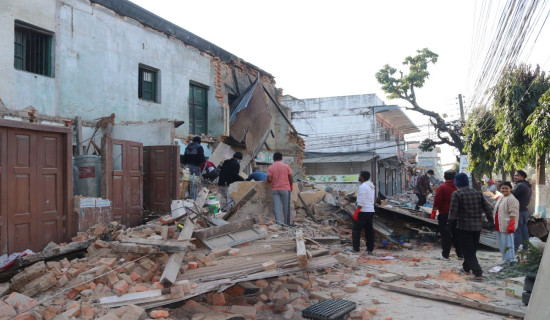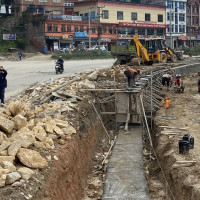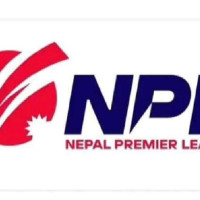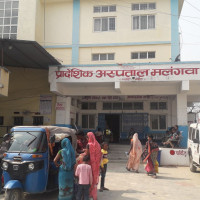- Saturday, 6 December 2025
Our approach to responding to loss and damage is a country-led and bottom-up one: Diong
Ibrahima Cheikh Diong is the Executive Director of the Fund for Responding to Loss and Damage (FRLD). Indira Aryal, a reporter with this daily, spoke with Mr Diong about the mandate and mission of the Fund, and how developing countries like Nepal can access it more easily.
Excerpts:
First of all, please tell me more about the mandate and mission of the Fund for Responding to Loss and Damage?
As you may know, the Fund for Responding to Loss and Damage has been in the making for years. Vulnerable countries are suffering the most from negative effects of climate change, experiencing both economic and non-economic losses, and a strong case for the creation of a fund entirely dedicated to dealing with losses and damage was made. Here we are, we are now working to operationalise the Fund. In my view, the establishment of the Fund is a great reflection of global solidarity as it shows what we can achieve when countries come together. The losses and damage from climate events can be vast, and often affect the most vulnerable people the most. The damage to infrastructure can also be extensive, and in some cases, the capacities of governments to respond may be limited. The Fund’s mandate is to assist developing countries that are particularly vulnerable to the negative impacts of climate change to respond to both economic and non-economic loss and damage, including from extreme weather events and slow-onset events. We aim to ensure that our responses are timely, and that no one is left behind.
So, where are we now and how is the Fund being operationalised?
As I have alluded to before, I think the establishment of the Fund is really a very good example of global solidarity. During COP28 in Dubai, the international community made a call for the establishment of the Fund, and a decision was made to do this as quickly as possible because of the urgency to address climate-induced losses and damage. It is remarkable to see that within a year, a lot has been achieved, particularly from a governance point of view:
• Firstly, we selected the Philippines as the host country of our Board, giving the Fund and the Board a home.
• Secondly, a decision was made for the World Bank to host the secretariat of the Fund, at least for the first four years, and this has also been done.
• A key focus area has been the mobilisation of resources to support the work of the Fund, and we have been working toward getting more pledges to support the Fund. To date, 27 countries have made pledges of about $766 million, and over $300 million of this has already been received. We are grateful to see that the pledges being honoured.
• Finally, another significant step was the hiring of an Executive Director to lead the work of the secretariat so that we can implement the decisions of the Board. I took office in November 2024.
As you can see, we have made remarkable progress in firming up the Fund’s governance structures. Our next step is to ensure that we begin to deliver on our mandate - supporting countries in addressing losses and damages from climate change. During our fifth board meeting in Barbados, the Board launched what we called the Barbados implementation Modalities, where we allocated $250 million to support early interventions. This shows that we are moving from finalising issues of governance to focus on operational matters so that we can begin to deliver on our reason for being.
Is the Fund focusing on supporting the needs of LDCs and SIDS?
Looking at our mandate, the Fund was created to support the most vulnerable countries. Unfortunately, if you assess the impact of climate change, you can see that the small island states and the least development countries are the most affected. So, our primary objective is to make sure that they are covered in our support as soon as possible. In fact, under the Barbados Implementation Modalities, the Board has dedicated 50% of the early intervention resources to the SIDS and the LDCs as they heavily affected by disasters like tropical cyclones, floods and drought. Obviously, this does not mean that the other vulnerable countries are excluded – in fact, we are working towards that with urgency. Part of the reason why we are here in Nepal is to help us understand the landscape and the challenges faced by other regions so that we can be effective in addressing their needs. Our solutions must be tailored to the needs of the countries we are assisting.
How will the Fund address the unique risks facing by the high mountain countries like Nepal?
As the Fund, we recognise that a one size fits all approach will not work. Each region and indeed each country has its own unique challenges, and as I said earlier, we are here to understand these differences. It is my commitment to understand the challenges and the uniqueness of Nepal, and other mountain countries as a good starting point towards finding the right solutions. We strongly believe that to be sustainable in our responses, we must drive for country-led initiatives that address the specific needs of a country. By understanding the landscape, the situation, and the challenges of a country, we ensure that the support that we provide is tailored accordingly.
Let me also emphasise that we as the Fund, recognize that we are not the only players in the climate financing space supporting countries. Our intention is to always find complementarities between us so that we can coordinate our responses. As much as possible, we will be joining forces, ensuring we can provide the right support.
How is it easy to access to the fund?
Our first step in building up to the operationalisation of the Fund has been the mobilisation of essential resources to enable us to support countries before we can make it accessible to those who need the support the most. The Fund for Responding to Loss and Damage is the latest to be added to climate funds, and as we operationalise the Fund, we are committed to making sure that accessibility simple and nimble. We are taking lessons from other funds, and we want to make sure that our processes and procedures for evaluating opportunities for funding are accurate, simple and accessible to all.
How would you foresee addressing climate raise loss and damage?
Our Board has been made it very clear that to be successful as a fund, we must drive for country-led initiatives. This requires that countries assess and understand their needs as the foundations for engaging the Fund. This will allow us to focus on the priorities and needs of the country and enable us to bring real value on the ground. As I indicated earlier, we're not the only fund in climate financing, and our intention is to provide the support to countries, and in our case, it is to address loss and damage effectively.
You are here, first time in Nepal for Sagarmatha Sambaad. What do you expect to see out of this dialogue?
Let me stress that I am delighted to be here in Nepal for the first time. I find the people to be extremely kind, generous and welcoming. It is also extremely special for the Fund to be here for the first edition of this important dialogue, which, from what I understand, is going to serve as a platform and an opportunity to have great conversations on how we address the uniqueness of the mountainous countries. We are looking forward to conversations on funding, on partnership, and on coming together - conversations which we believe are extremely critical in providing the right solutions to countries that need the support. The dialogue is certainly off to a good start, and I look forward to attending many more future editions. By bringing different parties together, Nepal is certainly showing leadership, vision, and a commitment to finding the solutions that we need so that no one is left to be behind when it came to losses and damage.I'm happy to be here and look forward to many more dialogues like this.















